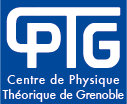-
Physique des particules
0The Large Hadron Collider (LHC) at CERN has very successfully begun to explore the TeV energy scale, testing our understanding of fundamental interactions in previously unexplored kinematic domains. We are thus entering a new era in particle physics. There are high hopes for groundbreaking discoveries shedding light on electroweak symmetry breaking (be it via the Higgs mechanism or some other new dynamics) and new physics beyond the Standard Model (SM) of electroweak and strong interactions.
The first two talks in this session by T. Stavreva and F. Arleo describe how to obtain precise predictions for observables at hadron colliders despite the inevitable presence of strong interaction dynamics which is not accessible by a perturbative treatment. Not only are the methods described here interesting in their own right, they are in fact a prerequisite for any new physics searches at the LHC.
There is strong theoretical motivation to expect new physics beyond the SM at the energies probed by the LHC. Some of the most popular ideas (supersymmetry, new particles, extended gauge symmetries, extra dimensions) and the impact of the LHC results on dark matter and dark energy will be discussed in the four talks by A. Wingerter, S. Kulkarni, P. Serpico and G. Drieu La Rochelle.
The arguably most important mission of the LHC is the discovery of the Higgs boson that is the last missing piece in the SM, and preliminary results from March this year indicate the presence of a relatively light Higgs boson in the mass range from 122 to 128 GeV. An overview of the current status of the Higgs search at the LHC will be presented in a review talk by A. Djouadi (CERN).
The topics covered in the 6 shorter talks (20 - 30 min) will give an overview over (a part of) the research conducted in the particle theory groups in Grenoble and Annecy.
Speakers: F. Arleo, A. Djouadi, G. Drieu La Rochelle, S. Kulkarni, P. Serpico, T. Stavreva, A. Wingerter
-
Systemes integrables
1The notion of integrability is based on an essential property, namely the existence of an "adequate" number of conserved quantities in the system. This "adequate" number then allows for the full resolution of the model, i.e., to calculate exactly (without using approximations or perturbative techniques) all its physical quantities, such as energies, momenta, correlation functions, etc... Analytical and algebraic developments have grown in the 80s (starting with the study of spin chains) and there exists now a huge arsenal of mathematical tools to study such systems. Of course, not all systems are integrable, but, surprisingly enough, there are many integrable systems in physics, even if integrable techniques are not always used to solve them.
Integrable systems take place in many areas, in physics or in mathematics. In physics, they are involved in field theory and symmetries (especially in elementary particle physics, in string theories and in supersymmetric Yang-Mills theories), in statistical mechanics (for example in so-called ASEP models, for asymmetric exclusion principle), or condensed matter physics (e.g. in models used to describe nano-technology materials such as carbon nano-tubes). In mathematics, integrable systems are themselves the basis for the development of a particularly rich set of new mathematical structures (quantum groups, deformed algebras, Hopf and quasi-Hopf structures, etc...).
Speakers: J. Avan, J. Drummond, J.-M. Maillet, R. Mélin, C. Schenke
-
Matiere molle/Biophysique
2This session will focus on applications of soft matter concepts and other methods from statistical physics to problems of biological interest, from cell adhesion to chromosome dynamics or protein structures.
Speakers: R. Everaers, G. Feverati, A. Nicolas, O. Rivoire
-
Energie et thermoelectricite
3This session will focus on some of the fundamental aspects related to the field of "renewable energies" as commonly coined in medias. From photovoltaics, photosynthesis to thermoelectricity, the field remains an open playground for fundamental science, even though already at an industrial level for some applications. As a matter of fact, the complex interplay between electronic, excitonic and vibrational degrees of freedom at the origin of the generation (conversion) and transport of energy in inorganic, organic or hybrid systems of various dimensionality, remains largely unknown and the basic phenomena controlling e.g. the "energy conversion yield" are mostly still to be understood. It is the role of the present half-a-day session to start fostering in Grenoble and beyond a community of experts from various backgrounds interested in the field.
Speakers: A. Chin, C. Delerue, S. Fratini, N. Mingo
Choose timezone
Your profile timezone:

